Victoria Park
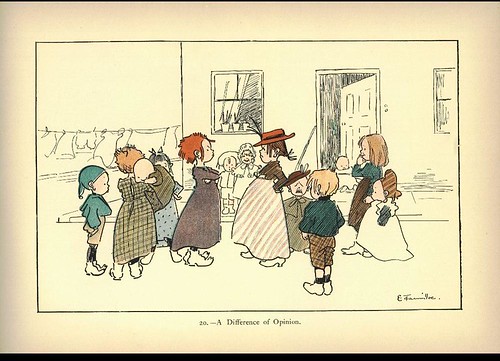
A Difference of Opinion

A Man and His Little Brother

A Regular Turk
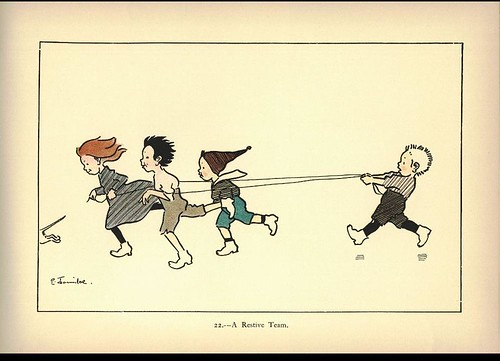
A Restive Team
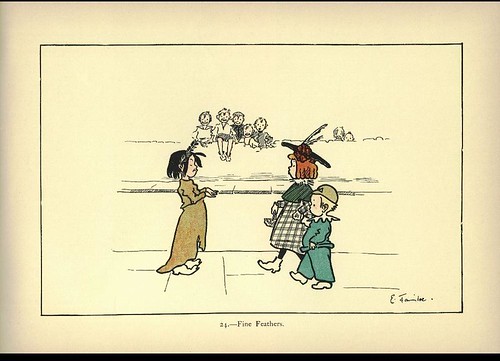
Fine Feathers
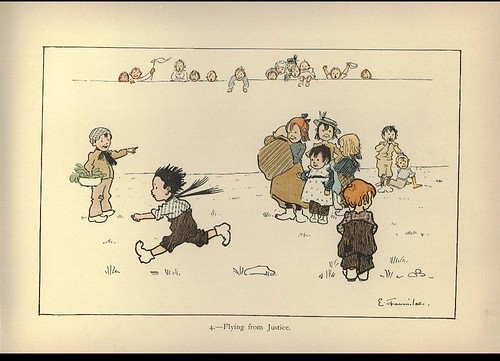
Flying From Justice

Kensington Gardens - Air Balloons
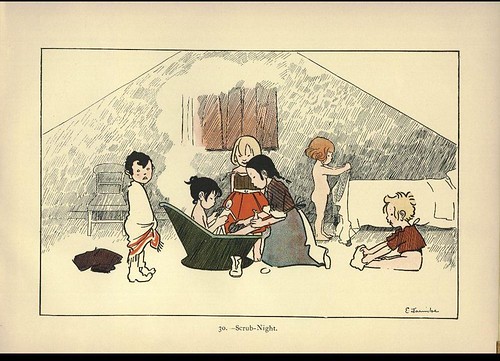
Scrub Night
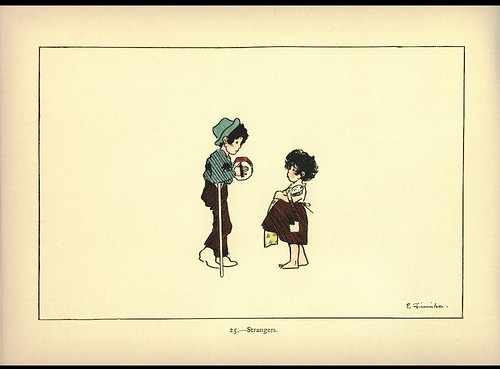
Strangers
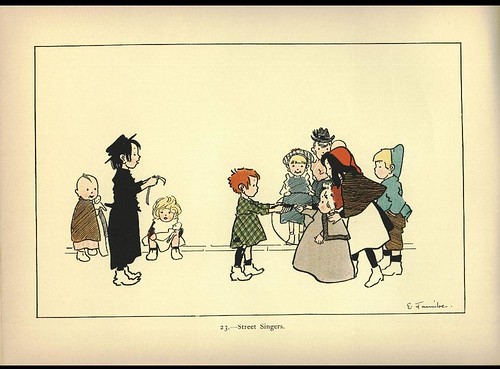
Street Singers
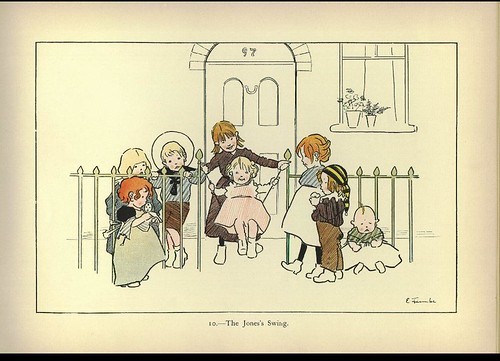
The Jones Swing
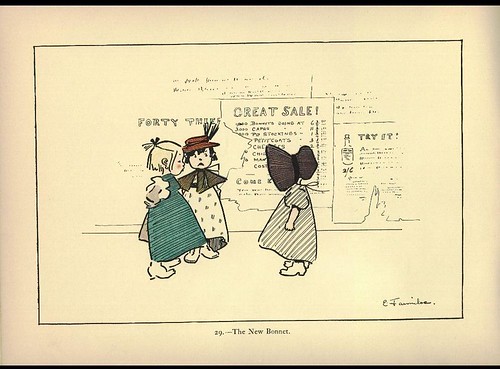
The New Bonnet
These charming chromolithographs of children from 1899 by Edith Farmiloe appear in a book called 'Rag, Tag and Bobtail', available from Braunschweig Digital Library (click 'Start.html') I confess to not having read any of the verses by Winifred Parnell in this ~70 page book : temporary bandwidth problem. The images above have all been lightly background cleaned.
There is little online about Farmiloe*, although the paragraphs below (out of sequence) from a contemporary review by Walter Shaw Sparrow in an arts magazine called 'The Studio', are alone worth reading for the authors delicate interplay of patronising attitude (well it was 1899!), attempted deference and subdued incredulity at the wily ways of feminine illustration ability.
*Known but unavailable from Amazon; appears in a few ebay auctions; otherwise pops up in a few antiquarian bookstore listings.
'The Studio' is one of a couple of old art magazines available from Design Research Publications. The excerpted article below - 'Some Drawings by Mrs Farmiloe' : Walter Shaw Sparrow - is from Issue 81: December 1899.
In passing, I came across this work that seems pretty good: 'The Victorian Illustrated Book' Ed. by Richard Maxwell, 2002. [googlebooks]
"Mrs. Farmiloe is the second daughter of Colonel the Hon. Arthur Parnell, a retired officer of the Royal Engineers and a second cousin of the late Irish leader, Charles Stewart Parnell. She has four sisters and four brothers, and a talent for humorous drawing runs in the family. Her husband, the Rev. William D. Farmiloe, is Vicar of St. Peter's in Soho. The parish, lying chiefly between Rupert Street and Great Windmill Street, is thronged with children of all nationalities, and Mrs. Farmiloe never tires of watching the youngsters play when school is over, Something of what may be seen there is admirably represented in the artist's new book, "Tag, Rag, and Bobtail" (London: Grant Richards). Herein the drawings are reproduced in colour, and one finds everywhere plenty of sweet ingenuousness with plenty of gay and charming movement and humour. It is a book to be treasured, like its predecessors of last year–a work entitled "All the World Over." [..]
One other point is worth noting in connection with the difficulty that Mrs. Farmiloe experiences in handling details. She tells me that she cannot sketch well from nature, as she is bewildered by the great number of lines which have to be drawn one by one; but when she turns away from the object and sets herself clearly to visualise it, to see it clearly with her mind's eye, the feeling of bewilderment leaves her, and the model's chief lines are soon upon paper. This skill in drawing from memory is often very helpful to Mrs. Farmiloe, for children never know when they are being " took," and consequently never pose and look unnatural. She can take part in their amusements and yet be their graphic historian. On the other hand, it is also a dangerous way of working, since it is apt to give rise to stereotyped conventions, to endless repetitions, so that this tendency ought to be counteracted by patient studies from the life, The drawings thus made may be bad, yet they store the mind with new and varied material, which is certain to find its way into the next memory-sketches.
And I say this because a few children in Mrs. Farmiloe's art have a family likeness, a set type of face and figure. We must remember, nevertheless, that in writing about a lady of genius a man may easily give bad advice. "Women," said Goethe; "do the most through imagination and temperament." Their best work has ever been done intuitively, under an instinctive rather than technical guidance. They have eyes to see and hearts to understand a great many subtle things unperceived by men; hence we are often seriously at fault when we try to influence their ways of working. This is what Mr. Ruskin found out in the case of Lady Waterford, the greatest woman-artist of the century, who was rendered timidly self-conscious by a course of systematic instruction. Nature was her best guide, as Mr. Ruskin soon acknowledged.
In brief, academic studies do much for men, but it is doubtful if they are ever very useful to women of first-rate ability; and thus I may be altogether wrong in my remarks on the benefits that Mrs. Farmiloe would receive from studying from the life. This is a point which she alone can decide, guided by her intuitions."
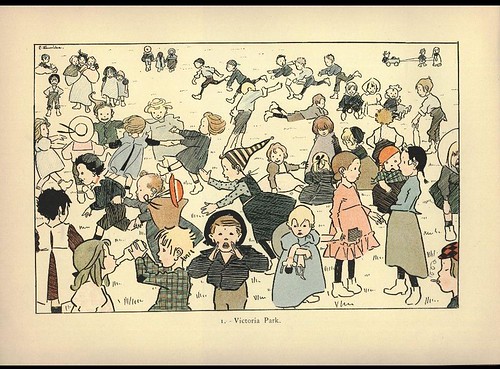



















10 comments :
I was going to comment on the illustrations themselves (general fondness for children's literature and its illustration), but the introduction of Walter Shaw Sparrow takes things in a different direction.
I agree Sparrow sounds like he didn't think all that highly of Farmiloe, or for that matter of women's academic training. Yet--right next to me as I type--I've got his tome Women Painters of the World (1905, one of my lucky finds) with Elisabeth Vigée-Lebrun's 1790 self portrait on the cover. The book is one of the pioneering works on women artists.
His preface begins, "What is genius? Is it not both masculine and feminine? Are not some of its qualities instinct with manhood, while others delight us with the most winning graces of a perfect womanhood? Does not genius make its appeal as a single creative agent with a two-fold sex?"
Now, of course Sparrow goes on to complicate this, and considering the date of the book, I wonder whether he might have been reading the now-reviled Otto Weininger on gender, so he comes up with "the bisexuality of genius has limits in art, and those limits should be determined by a worker's sex" (each gender has its strength and don't get too strong in the other gender's strengths), but while he's irritating in his gender-traits-are-destiny outlook, which plenty of people even in 1905 would have argued about, at least he was interested in what women were doing.
But I also suspect Sparrow was more interested in easel painting than in illustration, especially children's illustration. Farmiloe definitely doesn't appear in Women Painters. Still, the other books he's got listed in his "Art and Life Library" are The British Home of To-day: A Book of Modern Domestic Architecture and the Applied Arts and The Gospels in Art: The Life of Christ by Great Painters from Fra Angelico to Holman Hunt so I don't know quite what his main expertise was.
(Yikes, that was a longer comment than some of my blog posts! alarming!)
Thanks. It's interesting to have some background filled in.
I guess I come away from that quote of Sparrow above somewhat undecided and perhaps it's more for a woman to decide the overall effect. By that I mean that I make an allowance for the fact that what he was writing was a trade mag and it was a criticism rather than a review; meaning he operated from a point of authority, at least to an extent.
Rather than sensing any particular disdain for Farmiloe necessarily, it seemed to me like he had picked up some hitherto rare species of bird and he was turning it around in his hands and describing it in his own logical framework. And that artistic framework wasn't used to a professional female illustrator. It was only around that time - late 1800s - that art became popular for women as a well-rounded pastime to pursue wasn't it? So I have sympathy for his trying to wrestle with the idea of what women bring to the pursuit and what, if any, training they require. I thought he read as a kind of gentle buffoon from our perspective. I didn't think it was unduly disrespectful for the time (but again, maybe that's not my call to make, as a guy).
Well, on the whole I agree with you. I'd have to get more familiar with his work and his criticism for Studio (which I haven't really done more than dip into) to have a well-thought-out sense of his views.
As for the history of women artists as professionals, well, let me get back to you on that (I can expound in appalling detail and will spare the blog readers) but certainly they'd existed for centuries, just not in as large numbers as began to be the case by the 1890s. By that time women were even studying from nude models (here and there, I mean aside from at home with the family which I suppose some people managed to do).
these are charming--i agree. and thanks for the links.
perhaps we know the names of many more female artists from that time is because the import of japanese goods caused a shift in the distinction between art and craft.
perhaps we know the names of many more female artists from that time is because the import of japanese goods caused a shift in the distinction between art and craft.
I'm not convinced that that's why. For one thing, most of the women artists whose work was written about were working in traditional fine-art genres. Yes, import of Japanese goods caused changes in how things were viewed, but I wouldn't say the early Arts & Crafts movement was propelled by Japanese imports so much as by reaction to industrialization and factory-made products. (Plus that fine "craft" items have always been admired in the West, just not always in terms of artist name-recognition.)
Granted, by 1899 Arts & Crafts meets Japonisme meets high quality color printing techniques meets art-for-art's-sake-aestheticism etc. etc. and so there's that wonderful wave of fin-de-siecle book illustration. But I don't know that I'd say women are more prominent in that than in say for instance sculpture, where women start getting very active around 1900. A surprising amount of public sculpture in the US 1900-1940 was done by women. I can think of more female sculptors circa 1900 than illustrators, offhand.
i know next to nothing about sculpture, so i can't respond to that, but i can comment on a few things you said.
one is about arts and crafts not arising from the import of japanese goods--they are directly related. yes, the A&C movement was against the industrial revolution, but that may have been a factor in the huge attraction to the japanese goods with their strongly nature-based aesthetics and lines.
i don't know if you happened to read my post from yesterday, but most of the major players in the arts and crafts movement credit the japanese themselves.
as to women... it is true that one can think of one marisot for 3 dozen monets, one cassatt for 24 steinlens, etc. but i can also list off a few dozen women who worked in many media--printing (ie woodblock), plus jewelry, plus embroidery, plus metal work....
i can't really think of embroidery taken as an artform until the women of glasgow took it up. what about jessie m king, who illustrated children's books and grown-up's books and who made jewelry and pottery; or the whole gang of american women printmakers who moved to paris and got involved with everything (including, i believe, each other).
I don't really disagree with anything you say. I'm not an expert on the Arts & Crafts movement (although very fond of it) and certainly not on Japonisme, so I'm perfectly willing to be corrected on the connection between the two. I'm more familiar with the effect of Japanese prints on French art than British.
And I'm not saying there weren't loads of women working in the so-called decorative arts at this period--there were. I just don't think they were written about as much as those who painted and sculpted. That's not a value judgment on my part at all. It's our job to give them due credit.
Not trying to annoy anyone today but it appears I am succeeding right and left, alas. (And: I'm just looking at the "cloven" inscription written long ago in my Slang and Euphemism dictionary so no brickbats, ok? I'll go get up to date on the latest Japonisme posts.)
you know, my reading is SO SKEWED that i admit, i have no idea about who is "famous" and who is not in any circles other than the one i focus on, and i'm always astonished that not everyone is aware of these people who are my gods!
meanwhile, speaking of catching up, did you see this one?
That's a gorgeous post and I'm embarrassed to have missed it when it first came out.
My reading is terribly skewed too. But I'm not sure in what direction.
Post a Comment
Comments are all moderated so don't waste your time spamming: they will never show up.
If you include ANY links that aren't pertinent to the blog post or discussion they will be deleted and a rash will break out in your underwear.
Also: please play the ball and not the person.
Note: only a member of this blog may post a comment.